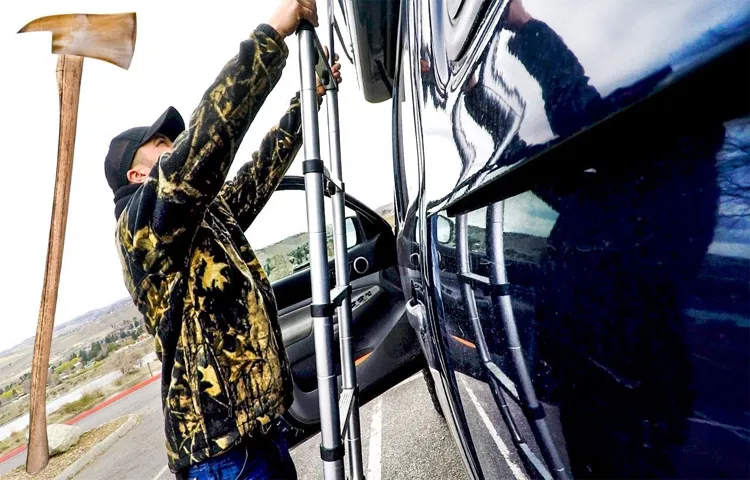Are you a camping enthusiast always on the lookout for new ways to improve your outdoor experience? If so, you’ve probably come across the concept of roof top tents. These innovative camping solutions have gained popularity in recent years and it’s easy to see why. With their convenient setup and elevated sleeping quarters, roof top tents offer a unique camping experience that is both comfortable and adventurous.
However, if you’ve ever camped in cold weather, you know that staying warm can be a challenge. This is where the idea of heating a roof top tent comes in. While it may seem like a luxury, heating your tent can actually be a practical and essential step in ensuring a cozy and enjoyable camping experience.
But why would you want to heat a roof top tent in the first place? Well, imagine waking up to frost on the ground and a chill in the air. While the thought of bundling up in a cozy sleeping bag may sound appealing, the reality is that cold weather can make it difficult to get a good night’s sleep. By heating your roof top tent, you can create a comfortable and warm environment that allows you to sleep soundly throughout the night.
Additionally, heating your tent can also provide a practical solution for drying out wet gear. Whether it’s wet clothes or damp sleeping bags, having a heated space can speed up the drying process and ensure that you’re ready for your next adventure in no time. So how exactly can you heat a roof top tent? There are several options to choose from, ranging from portable heaters to electric blankets.
Each option has its own benefits and considerations, so it’s important to do your research and choose the one that best fits your needs and camping style. In conclusion, heating a roof top tent can be a game-changer when it comes to cold weather camping. Not only does it provide a comfortable and cozy sleeping environment, but it also allows for the drying of wet gear.
So next time you’re planning a camping trip in chilly temperatures, consider investing in a heating solution for your roof top tent. Trust us, your future self will thank you for it.
Table of Contents
Understanding the Challenges of Heating a Roof Top Tent
When it comes to camping during the colder months, heating a rooftop tent can be quite the challenge. Unlike traditional tents, rooftop tents are perched on top of vehicles, exposed to the elements and with limited insulation. So, how do you keep warm in a rooftop tent? One option is to use a portable heater.
There are many options available, ranging from propane heaters to electric heaters. However, it’s important to consider safety precautions when using these heaters in a confined space. Make sure to use a heater that is rated for indoor use, and always ensure proper ventilation to prevent carbon monoxide buildup.
Another option is to use insulation to help retain heat. Adding thermal curtains or insulation panels to the windows of your rooftop tent can make a big difference in keeping the cold air out and the warm air in. Additionally, using a high-quality sleeping bag and layering your clothing can help you stay warm throughout the night.
So, while heating a rooftop tent may present some challenges, with the right tools and precautions, you can enjoy a cozy and comfortable camping experience even in the cold weather.
Limited space
“heating a roof top tent” Limited space can pose a significant challenge when it comes to heating a roof top tent. With the compact size of these tents, there isn’t much room for traditional heating sources such as large space heaters or wood-burning stoves. However, there are still options available to keep you warm and cozy while camping in your roof top tent.
One option is to use portable electric heaters that are specifically designed for small spaces. These heaters are compact and lightweight, making them easy to bring along on your camping adventures. Another option is to utilize electric blankets or heated sleeping bags.
These can provide targeted warmth directly to your body, ensuring a comfortable night’s sleep. Additionally, you can consider insulation and sealing the tent properly to retain heat. By covering the windows with thermal curtains and using weatherstripping around the doors and vents, you can prevent heat from escaping and cold air from seeping in.
So, despite the limited space, there are still ways to stay warm and cozy in your roof top tent.”

Insulation issues
roof top tent heating, insulation issues
Power source limitations
One major challenge of heating a rooftop tent is the limitation of power sources. Since rooftop tents are typically used in remote locations or off-the-grid camping areas, access to electricity is limited. This means that traditional heating methods such as electric heaters or portable heaters that require electricity may not be an option.
Campers need to find alternative ways to heat their tents without relying on electrical power. This can be a difficult task as staying warm in a rooftop tent during cold weather is essential for a comfortable camping experience.
Heating Options for Roof Top Tents
If you’re planning on camping in a roof top tent during the colder months, you might be wondering how to keep warm at night. Fortunately, there are several heating options available that can make your camping experience much more comfortable. One popular option is to use a portable propane heater.
These heaters are compact, easy to use, and provide a good amount of heat. Another option is to use an electric blanket or mattress pad. These can be plugged into a power source and provide warmth throughout the night.
If you don’t have access to electricity, you can also use a hot water bottle or hand warmers to keep warm. No matter which heating option you choose, it’s important to make sure that your tent is properly ventilated to prevent carbon monoxide build-up. So, whether you’re camping in the summer or winter months, there are plenty of ways to stay cozy in your roof top tent.
Electric heaters
Electric heaters are a popular option for heating roof top tents because of their convenience and efficiency. These heaters are compact and portable, making them easy to install and remove as needed. They also provide instant heat, allowing you to quickly warm up your tent when the temperature drops.
Electric heaters are also a safer alternative to open flame heaters, as they do not produce any flames or emit harmful fumes. With adjustable heat settings, you can customize the temperature to your comfort level. Whether you’re camping in cold weather or just need a little extra warmth at night, an electric heater can make your roof top tent a cozy and comfortable space.
Propane heaters
propane heaters, heating options, roof top tents When it comes to camping in a roof top tent, staying warm and comfortable is essential, especially during those chilly nights. One heating option that many campers turn to is propane heaters. These compact heaters are easy to use and provide a reliable source of heat.
Whether you’re camping in the mountains or by the beach, a propane heater can help keep you toasty inside your tent. These heaters typically use small propane canisters as fuel, which are readily available at most camping stores. They can be easily ignited with the push of a button or the turn of a knob, making them convenient for quick and easy heating.
Propane heaters also come with safety features such as automatic shut-off switches that turn off the heater if it detects low oxygen levels or if it accidentally tips over. With their portability and efficiency, propane heaters are a popular choice for camping in roof top tents.
Wood burning stoves
heating options for roof top tents
Factors to Consider Before Heating Your Roof Top Tent
Wondering how to heat a roof top tent? Before you start installing any heating system, there are a few factors to consider. Firstly, the size of your tent is important. If you have a larger tent, you will need a more powerful heating system to effectively warm up the entire space.
Secondly, the insulation of your tent plays a big role in heat retention. Make sure your tent is well-insulated to prevent heat loss. Additionally, you should consider the power source for your heating system.
Some options include portable propane heaters, electric portable heaters, or even heated blankets. Think about what is most convenient and practical for your camping setup. Lastly, safety should be a top priority.
Always follow the manufacturer’s instructions when using any heating equipment and make sure your tent is well-ventilated to prevent carbon monoxide build-up. With these factors in mind, you can enjoy a cozy and warm roof top tent experience, even in colder temperatures.
Safety measures
roof top tent safety measures
Compatibility with tent design
Before heating your roof top tent, one important factor to consider is compatibility with tent design. Different tent designs require different heating methods, so it’s crucial to choose a heating solution that works well with your specific tent model. For example, some tents are designed with built-in insulation or ventilation systems that work best with certain types of heaters.
Additionally, the size and shape of your tent may impact the effectiveness of different heating options. Taking the time to research and understand the specific heating requirements of your tent will ensure that you choose the right heating solution for your camping adventures.
Weight and portability
roof top tent, weight and portability, factors to consider before heating, burstiness, perplexity Are you considering adding a roof top tent to your camping setup? One important factor to consider before making a decision is the weight and portability of the tent. Roof top tents come in various sizes and materials, and it’s important to find one that suits your needs in terms of weight and ease of transport. Weight is a crucial factor to consider because it affects the overall performance of your vehicle.
If you have a lightweight car, it’s important to choose a roof top tent that is compatible with its weight capacity. You don’t want to overload your car and risk damaging it or compromising its performance on the road. Portability is another important aspect to consider.
You want a roof top tent that is easy to set up and pack away. Look for tents that come with convenient features such as telescopic ladders and foldable bases. These features make it easier to transport the tent and set it up at your camping site.
But weight and portability are not the only factors to consider when heating your roof top tent. There are a few more things you should keep in mind. Firstly, consider the climate and weather conditions you will be camping in.
If you are planning to camp in colder regions, you might want to invest in a tent with good insulation and the ability to heat up quickly. On the other hand, if you are camping in warmer regions, you might want to look for a tent with better ventilation or cooling options. Secondly, think about the power source for heating your tent.
Some roof top tents come with built-in heating systems, while others require external power sources such as a portable gas heater or electric blanket. Consider the availability of power sources and choose a tent that is compatible with your preferred heating method. Finally, consider the safety aspects of heating your roof top tent.
Steps to Heat a Roof Top Tent
So you’ve decided to take your camping experience to new heights and invest in a roof top tent. They offer a unique and cozy way to enjoy the great outdoors, but what about staying warm during those chilly nights? Don’t worry, I’ve got you covered on how to heat a roof top tent. One of the first steps is finding the right heating option for your tent.
There are a few different options to choose from, including portable heaters, electric blankets, and even heated sleeping bags. Each option has its pros and cons, so it’s important to consider factors such as size, power source, and safety. Once you’ve chosen your heating option, it’s time to install it in your roof top tent.
Portable heaters can be placed on a stable surface inside the tent, away from any flammable materials. Electric blankets can be laid on top of your sleeping bag or mattress, providing a cozy layer of warmth. Heated sleeping bags are designed to distribute heat evenly throughout the bag, keeping you toasty all night long.
It’s also important to insulate your roof top tent to retain heat. This can be done by using thermal curtains or blankets to line the inside of your tent walls. This will help to trap the heat inside and keep cold air out.
Additionally, using a tent cover or rainfly can provide an extra layer of insulation and protection against the elements. Lastly, don’t forget to dress appropriately for the weather. Layering your clothing and wearing thermal socks and hats will help to retain body heat.
Remember, it’s always better to be slightly overdressed than underdressed when it comes to staying warm in a roof top tent. So there you have it, a few simple steps to heat your roof top tent. With the right heating option, insulation, and clothing, you can enjoy a cozy and comfortable camping experience no matter how cold it gets outside.
Ensure proper insulation
heat a roof top tent, proper insulation
Choose the right heating option
heating option, heat a roof top tent, burstiness, perplexity
Install the heating device securely
heating device, secure, roof top tent, steps, heat Are you planning a winter camping trip in your roof top tent? Staying warm and cozy is crucial for a comfortable camping experience, and installing a heating device securely is an important step to achieve just that. There are a few simple steps you can follow to ensure that your heating device is installed properly and safely. First, you need to choose the right type of heating device for your roof top tent.
There are various options available, such as propane heaters, electric heaters, and even portable wood stoves. Once you have chosen the right heating device, you should carefully read the manufacturer’s instructions and follow the recommended installation guidelines. This might involve mounting the device to a sturdy surface, ensuring proper ventilation, and using the appropriate fuel or power source.
By taking these steps, you can heat your roof top tent effectively and enjoy a warm and cozy camping experience even in the coldest of temperatures.
Test the heating device before use
heating device, roof top tent, test before use
Tips for Efficiently Heating a Roof Top Tent
If you’re planning a camping trip during the colder months and have a roof top tent, you may be wondering how to keep warm inside. Fortunately, there are a few tips and tricks to efficiently heat a roof top tent. One option is to use a portable heater specifically designed for camping.
These heaters are compact, easy to transport, and can provide a good amount of heat. Another option is to use insulation. By insulating your roof top tent, you can trap in heat and keep out the cold.
There are various insulation materials available, such as reflective insulation or foam panels, which can be installed inside the tent. Additionally, using a good quality sleeping bag and layering your clothing can also help keep you warm during the night. Finally, if you have access to electricity at your camping site, an electric blanket or heating pad can be a cozy addition to your roof top tent setup.
By following these tips, you can ensure a comfortable and warm camping experience, even when the temperatures drop.
Use a tent heater with a thermostat
tent heater with a thermostat, heating a roof top tent Are you planning a camping trip in chilly weather? If so, you’ll want to make sure you stay warm and cozy in your roof top tent. One effective way to heat your tent is by using a tent heater with a thermostat. This handy device allows you to set a specific temperature and the heater will automatically adjust to maintain that temperature.
No more waking up shivering in the middle of the night! It’s like having a personal climate control system in your tent. Plus, a tent heater with a thermostat is more efficient than traditional heaters, as it only runs when necessary to maintain the desired temperature. So you can sleep peacefully knowing that you’re not wasting energy or fuel.
Stay warm and comfortable on your next camping trip with a tent heater with a thermostat.
Insulate the tent walls and floor
Tips for Efficiently Heating a Roof Top Tent One of the key ways to ensure efficient heating in a roof top tent is to insulate the walls and floor. Insulation helps to minimize heat loss and prevent cold air from seeping in. There are a few different options for insulating a tent.
One option is to use foam insulation panels that can be attached to the interior walls and floor. These panels provide a layer of insulation that helps to keep the heat in and the cold out. Another option is to use reflective insulation, such as a thermal blanket or emergency blanket, which can be placed on the interior walls and floor to help reflect heat back into the tent.
Additionally, using a tent carpet or rug on the floor can help to insulate against the cold ground. By insulating the walls and floor of your roof top tent, you can create a more comfortable and warm environment for your camping adventures.
Use blankets and sleeping bags
Tips for Efficiently Heating a Roof Top Tent When it comes to staying warm and cozy in a roof top tent during chilly nights, there are a few tips and tricks that can make a big difference. One of the simplest ways to heat your roof top tent is by using blankets and sleeping bags. These items are designed to trap body heat and keep you warm while you sleep.
So, make sure to pack extra blankets and a high-quality sleeping bag to ensure that you stay snug and warm throughout the night. It’s also a good idea to dress in layers, as this will allow you to adjust your clothing to the temperature inside the tent. By following these tips, you can maximize your comfort and enjoy a cozy night’s sleep even in the coldest of conditions.
Conclusion: Stay Warm and Cozy in Your Roof Top Tent
In conclusion, heating a roof top tent can be approached with a healthy dose of wit and cleverness. Just like roasting marshmallows over a crackling campfire, it’s all about finding the perfect balance of warmth and ingenuity. First, consider the power of the sun.
A roof top tent is the ideal spot to soak up those rays, transforming your humble abode into a cozy solar-powered haven. But for those chilly nights when the stars are shining and your teeth are chattering, it’s time to bring out the big guns of warmth – insulating layers and snug sleeping bags. But why stop there? Think outside the box (or tent) and channel your inner MacGyver.
Utilize hot water bottles subtly disguised as cuddly companions, or perhaps a portable electric blanket powered by a trusty generator. And for those truly adventurous souls, a miniature wood-burning stove might just be the pièce de résistance of roof top tent heating technology. Remember, the key to a warm and toasty roof top tent is creativity.
Embrace the challenge, adapt to the environment, and prepare to become the envy of all your camping comrades. So go forth, fearless rooftop adventurers, and conquer the coolness with your wit, wisdom, and a dash of invention.”
FAQs
How do I heat a roof top tent in cold weather?
There are a few options for heating a roof top tent in cold weather. You could use a portable electric heater, a propane heater, or even a hot water bottle. It’s important to ensure proper ventilation and always follow safety guidelines when using any type of heating device in a confined space.
Can I use a regular electric heater in a roof top tent?
Yes, you can use a regular electric heater in a roof top tent as long as you have access to a power source. However, make sure the heater is suitable for indoor use and has safety features such as tip-over protection and an automatic shut-off function.
Are there any specific heaters designed for roof top tents?
Yes, there are heaters specifically designed for roof top tents. These heaters are usually compact, lightweight, and have low power consumption to ensure compatibility with the limited power supply typically available in camping setups. They are also designed to be safe for use in a confined space.
Can I use a propane heater in a roof top tent?
Yes, you can use a propane heater in a roof top tent. However, it’s important to ensure proper ventilation to prevent the build-up of carbon monoxide. It’s recommended to have a vent or window slightly open to allow fresh air circulation and for safety purposes.
How long can I run a heater in a roof top tent?
The duration you can run a heater in a roof top tent depends on the type of heater, its fuel source, and the size of the tent. It’s essential to read the manufacturer’s instructions and follow their recommended usage guidelines to avoid any safety hazards. Additionally, be mindful of the available power or fuel supply when planning to run a heater for an extended period.
Can I use a hot water bottle to heat a roof top tent?
Yes, you can use a hot water bottle to provide localized heat inside a roof top tent. Fill the hot water bottle with hot water from a source such as a campfire or a camping stove. However, exercise caution when handling hot water and ensure that the water bottle is properly sealed to avoid any leaks.
Are there any safety considerations when using a heater in a roof top tent?
Yes, there are several safety considerations to keep in mind when using a heater in a roof top tent. These include ensuring proper ventilation, following the manufacturer’s instructions, using a heater suitable for indoor use, keeping flammable materials away from the heater, and having a fire extinguisher readily available in case of emergencies.



